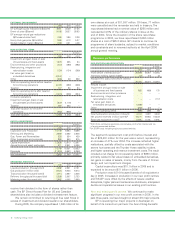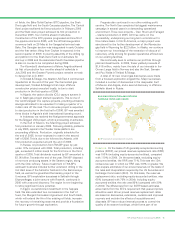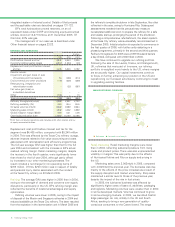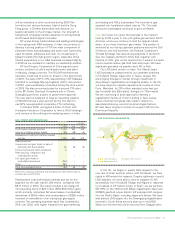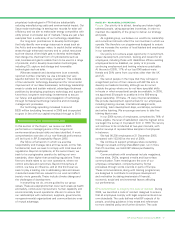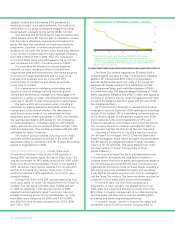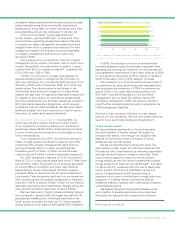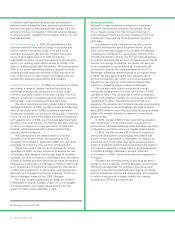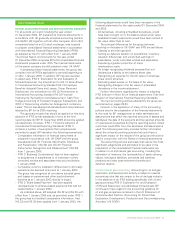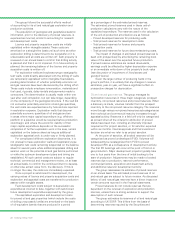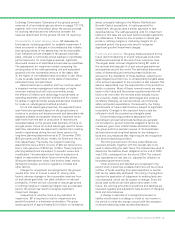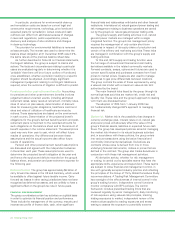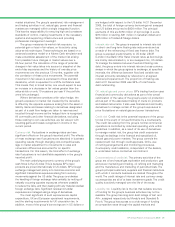BP 2005 Annual Report Download - page 24
Download and view the complete annual report
Please find page 24 of the 2005 BP annual report below. You can navigate through the pages in the report by either clicking on the pages listed below, or by using the keyword search tool below to find specific information within the annual report.
22 Making energy more
The group follows the successful efforts method
of accounting for its oil and natural gas exploration and
production activities.
The acquisition of geological and geophysical seismic
information, prior to the discovery of proved reserves, is
expensed as incurred, similar to accounting for research
and development costs.
Licence and property acquisition costs are initially
capitalized within intangible assets. These costs are
amortized on a straight-line basis until such time as either
exploration drilling is determined to be successful or it is
unsuccessful and all costs are written off. Each property is
reviewed on an annual basis to confirm that drilling activity
is planned and that it is not impaired. If no future activity is
planned, the remaining balance of the licence and property
acquisition costs is written off.
For exploration wells and exploratory-type stratigraphic
test wells, costs directly associated with the drilling of wells
are temporarily capitalized within intangible fixed assets,
pending determination of whether potentially economic oil
and gas reserves have been discovered by the drilling effort.
These costs include employee remuneration, materials and
fuel used, rig costs, delay rentals and payments made to
contractors. The determination is usually made within one
year after well completion, but can take longer, depending
on the complexity of the geological structure. If the well did
not encounter potentially economic oil and gas quantities,
the well costs are expensed as a dry hole and are reported
in exploration expense. Exploration wells that discover
potentially economic quantities of oil and gas and are
in areas where major capital expenditure (e.g. offshore
platform or a pipeline) would be required before production
could begin, and where the economic viability of that
major capital expenditure depends on the successful
completion of further exploration work in the area, remain
capitalized on the balance sheet as long as additional
exploration appraisal work is under way or firmly planned.
For complicated offshore exploration discoveries, it is
not unusual to have exploration wells and exploratory-type
stratigraphic test wells remaining suspended on the balance
sheet for several years while additional appraisal drilling and
seismic work on the potential oil and gas field is performed
or while the optimum development plans and timing are
established. All such carried costs are subject to regular
technical, commercial and management review, on at least
an annual basis, to confirm the continued intent to develop,
or otherwise extract value from, the discovery. If this is
no longer the case, the costs are immediately expensed.
Once a project is sanctioned for development, the
carrying values of licence and property acquisition costs and
exploration and appraisal costs are transferred to production
assets within tangible assets.
Field development costs subject to depreciation are
expenditures incurred to date, together with sanctioned
future development expenditure approved by the group.
The capitalized exploration and development costs
for proved oil and gas properties (which include the costs
of drilling unsuccessful wells) are amortized on the basis
of oil-equivalent barrels that are produced in a period
as a percentage of the estimated proved reserves.
The estimated proved reserves used in these unit-of-
production calculations vary with the nature of the
capitalized expenditure. The reserves used in the calculation
of the unit-of-production amortization are as follows:
••• Proved developed reserves for producing wells.
••• Total proved reserves for development costs.
••• Total proved reserves for licence and property
acquisition costs.
••• Total proved reserves for future decommissioning costs.
The impact of changes in estimated proved reserves is
dealt with prospectively by amortizing the remaining book
value of the asset over the expected future production.
If proved reserve estimates are revised downwards,
earnings could be affected by higher depreciation expense
or an immediate write-down of the property’s book value
(see discussion of impairment of fixed assets and
goodwill below).
Given the large number of producing fields in the
group’s portfolio, it is unlikely that any changes in reserve
estimates, year on year, will have a significant effect on
prospective charges for depreciation.
Oil and natural gas reserves The group manages its
hydrocarbon resources in three major categories: prospect
inventory, non-proved resources and proved reserves. When
a discovery is made, volumes transfer from the prospect
inventory to the non-proved resource category. The reserves
move through various non-proved resources sub-categories as
their technical and commercial maturity increases through
appraisal activity. Reserves in a field will only be categorized
as proved when all the criteria for attribution of proved
status have been met, including an internally imposed
requirement for project sanction, or for sanction expected
within six months. Internal approval and final investment
decision are what we refer to as project sanction.
At the point of sanction, all booked reserves will be
categorized as proved undeveloped (PUD). Volumes will
subsequently be recategorized from PUD to proved
developed (PD) as a consequence of development activity.
The first PD bookings will occur at the point of first oil or
gas production. Major development projects typically take
one to four years from the time of initial booking to the
start of production. Adjustments may be made to booked
reserves due to production, reservoir performance,
commercial factors, acquisition and divestment activity
and additional reservoir development activity.
The group reassesses its estimate of proved reserves
on an annual basis. The estimated proved reserves of oil
and natural gas are subject to future revision. As discussed
below, oil and natural gas reserves have a direct impact on
certain amounts reported in the financial statements.
Proved reserves do not include reserves that are
dependent on the renewal of exploration and production
licences, unless there is strong evidence to support the
assumption of such renewal.
The group estimates its reserves of oil and natural gas
according to UK SORP. This differs from the basis of
determining reserves required by the Securities and


